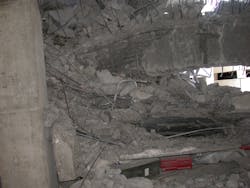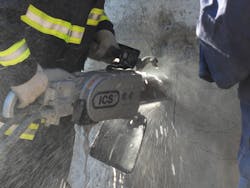Building Collapse: Maximum Survivability Within the Debris
Of all of the possible responsibilities that can fall to first responders, operating at a building collapse is one of the most dangerous and dynamically evolving. The collapse scene isn’t the place for inexperience, freelancing or experimentation. Things can go wrong in an instant, and injuries and fatalities often are the result.
It’s vital that all responders understand that operating safely within the arena is an integral part of training and discipline. Personnel must foster an attitude that identifies their skills and limitations. This attitude is paramount for survivability, for both rescuers and victims. It embraces the team efficiency concept. Working as a team for safer operations, staying focused on the assigned task and bringing the right equipment initially during the response are examples of team efficiency.
Proper training and expert performance that utilize rescue equipment provide the best chances for victim locating and removal from the debris. Furthermore, applying these concepts to void search can influence the outcome of the incident.
Building construction
A most significant area of proficiency for all firefighters for any response is the methods of building construction. From a rescuer’s standpoint, it might become necessary to push, pull, cut, breach, lift or tunnel through the materials that make up the collapsed structure.
Over the years, construction methods and techniques changed, but the laws of physics didn’t. It’s imperative that firefighters thoroughly understand how buildings are constructed and, more importantly, how they can collapse.
Many officers learned their decision-making process through experiences on the fireground. However, the clues that existed in the past, such as sagging floors, racking windows and doors, and smoke coming from separations in walls, might serve to be “too little, too late.”
It also is important for responders to be well-versed in the signs and characteristics that a collapse might occur in their jurisdiction, such as:
Age of the building. As a rule of thumb, most buildings have a life span of 75–100 years. Lack of proper maintenance drastically reduces their life span.
Weather. Buildings that lack upkeep and/or are left open to the elements will deteriorate and decay very quickly.
Improper alterations. Building owners who take shortcuts or alter structural components without a proper knowledge of construction invite trouble.
Natural disasters. Hurricanes, tornadoes and other storms can wreak havoc on a community and can lead to a large collapse area that involves multiple structures, which quickly can overwhelm local resources.
Construction collapses. Accidents during construction have resulted in catastrophic failures of structures.
Vehicles into buildings. Although most responders treat these incidents as nothing more than a “nuisance” alarm, the damaged component can result in a domino effect, bringing down the rest of the structure without any warning.
Gas explosions. The routine “smell of gas” can turn deadly for responders. Buildings have failed while responders investigated the source of the smell.
Fires. The incident commander (IC) is faced with two problems at these incidents: access to firefighters who might be trapped because of the collapse; and the fire still must be extinguished. Many departments focus all of their resources on rescue and none on suppression, with catastrophic results.
Collapse patterns
On arrival at the collapse, identifying the type of collapse that occurred is crucial. This helps to identify the type of voids that are created, which might provide some safe havens for trapped victims, and the shoring that must be incorporated prior to rescuers making entry into the debris pile. It also allows the IC to evaluate the scene to determine the safest areas for operations and staging and the logistical needs of the incident.
Lean-to floor collapse. This collapse occurs when the roof or floor supports fail on one side of the structure and the opposite side of the floor still is connected to the wall. It results in a void space that’s close to the remaining wall.
V-shape floor collapse. This collapse occurs when lower walls or floor joists fail because of heavy loads that are located in the center of the floor. It results in two voids, one near each exterior wall.
Cantilever floor collapse. This collapse occurs when one or more walls fail and the other end of the floor still is attached to the other bearing wall. This is the most dangerous type of collapse to operate in. Adequate shoring must be in place before operations can commence.
A-frame (tent) floor collapse. This collapse occurs when the flooring separates from the exterior bearing walls but still is supported by an interior wall(s) or partition(s). Voids are created near the center of the structure.
On-scene operations
Once the hazards are identified and collapse patterns are confirmed, the focus can be directed toward the best odds of survivability within these void spaces.
Reconnaissance. This phase is one of, if not, the most important phase of the operation. This sets the pace for the rest of the incident. It involves finding out what happened that led to the collapse, including a six-sided approach (front, rear, both sides, top and bottom), and it can include:
· Nature of the event (terrorism, structural failure, gas leak, tornado, etc.)
· Type of construction and materials used
· Use of the building (occupancy)
· A rough estimate of potential victims (this varies depending on occupancy)
· Potential additional hazards
· Incident scene control (incident management system)
· Identifying potential survival locations and determining priority for each location
· Utility control
· Fire concern (Did the fire cause the collapse or was it secondary to the collapse? Either way, suppression is a constant responsibility and concern.)
· Develop the formal incident action plan
· Initiate the emergency response plan
Surface area rescue. Initial responders might be faced with multiple victims at the surface, who might be incapacitated, walking wounded, lightly entrapped or fatally injured. Removal of these victims takes priority, but search specialists should further evaluate the pile to search for possible victim locations. This helps to identify areas where the search should start and where appropriate resources can be deployed.
Voids for possible survivable victims can be identified in several ways, including via the use of thermal imagers, search cameras, canine search professionals and visual/audible clues.
The direction of travel is determined by the recon report and the results of the surface area search.
It’s wise to stop and go “all quiet” during operations to listen for sounds from victims in the pile. Calls for help, shouts, and tapping on metal pipes and beams all have resulted in successful rescues of survivors.
Once a void is confirmed to contain a victim, rescuers go to work to gain access into the void. It might become necessary to breach through materials to gain access and to facilitate removal of the packaged victim. The initial access point might be suitable for entry, but once a victim is packaged for removal, the opening probably must be expanded. Breaching operations into the void should continue to facilitate this removal.
Rescuers and technical experts should construct emergency shoring in the areas that they enter and in the victim’s location to assist in disentanglement operations inside of the void spaces. During the search for victims and survivors, materials and debris should be removed from the pile and replaced with emergency shoring as rescuers traverse deeper into the pile.
Once at the victim location, a plan for disentanglement is needed with approval from medical specialists. Equipment must be brought into the void to free the victim(s), and many of these tools require room to operate. Additionally, these tools can exhibit considerable force, so injury can happen from exposure to their output in the form of energy and sparks/runoff. Consider the size of the void in which rescuers are operating.
There must be medical specialists pacing treatment and removal, rescue specialists performing disentanglement with tools and equipment, and additional personnel for atmospheric monitoring and engineering/integrity concerns. One can see that the void space can become quite cramped very quickly.
Once the void is cleared of victims, the appropriate markings for the result of the operation should be made.
Efficiency and accuracy
The response to any level of collapse or failure of a structure taxes even the most experienced and prepared department and requires a significant amount of resources, which represent varying skill sets for victim survivability. Responders include search specialists, engineers, rigging crews, advanced medical personnel and structural collapse specialists who are responsible for not only accessing the victim but determining the best route of travel for efficient removal. These decisions are indeed critical and time-driven. Efficiency and accuracy are paramount, because survivability for injuries that result from these events require early discovery, treatment and transport for success.

Michael Daley
MICHAEL DALEY, who is a Firehouse contributing editor, is a 37-year veteran who serves as a captain and department training officer in Monroe Township, NJ. He is a staff instructor at multiple New Jersey fire academies and is an adjunct professor in the Fire Science Program at Middlesex County College. Daley is a nationally known instructor who has presented at multiple conferences, including Firehouse Expo and Firehouse World. His education includes accreditations as a Chief Training Officer and a Fire Investigator, and he completed the Craftsman Level of education with Project Kill the Flashover. Daley is a member of the Institution of Fire Engineers and a FEMA Instructor and Rescue Officer with NJ Urban Search and Rescue Task Force 1. He operates Fire Service Performance Concepts, which is a training and research firm that delivers and develops training courses in many fire service competencies.









